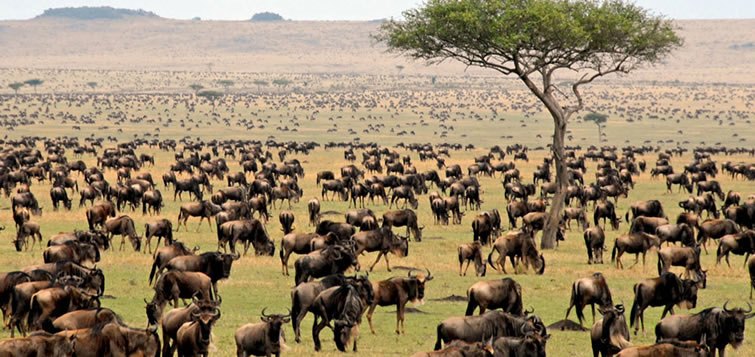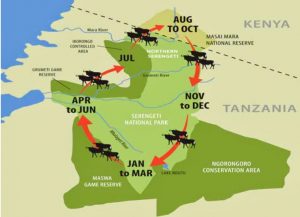 THE GREAT MIGRATION SAFARIS:
THE GREAT MIGRATION SAFARIS:- WHAT IS GREAT MIGRATION?
- SOUTHERN SERENGETI
- NORTHERN SERENGETI
Where and when it occurs?
The Serengeti Ecosystem, about 40,000 square kilometers is defined by the dominant Migration route of wildebeest. It comprises parts of the Ngorongoro Conservation Area in the south and Serengeti National Park. The Maswa Game Reserve, and other controlled areas in the east and Masai Mara Game Reserve to the north. More than two million animals participate in the Great Migration. The principal players are the wildebeest, whose numbers reach approximately 1.7 million, 200,000 Zebra and 500,000 Thomson’s gazelles. The main predators are lions, leopards, cheetahs and hyenas who await the annual Great Migration with eager anticipation.

Wildebeest and zebra spend the wet season in Tanzania’s Serengeti ecosystem. The dry season is spent in Kenya’s Masai Mara. There is neither start nor finish to their endless searching food and water, as they roam the Serengeti and Mara ecosystem in a sequence of life and death. There are lots of questions around when is best time to see the wildebeest migration? In our experience we discovered that the herds movements different every year. The timing of their migrations in both the rainy and dry seasons can vary considerably (by months) from year to year. At the end of the wet season (May or June in East Africa), wildebeest migrate to dry-season areas in response to a lack of surface (drinking) water.
Southern plains
The wildebeest masses migrate with the rain which occurs at different times each year. If the rain seasons start early in November herds move south from the northern woodland. The grass plains are rich in minerals that the wildebeest need to rear their young.
Southern plains-Central and western corridor
Between February-March is when one of the most miraculous times occurs. For 3 to 4 weeks, 90% of the female wildebeest give birth. Wildebeest may stay in the southern plains for several months where there are plenty of grasslands with grazing zebra and gazelle. At the end of rain season, the plains dry rapidly forcing the herds to move center, west and north again. Between May and June marks another great spectacle. The wildebeest meandering lines stretch for miles. Migration arrives in the western Serengeti between June and July.
Northern Serengeti woodland:
Wildebeest move through the northern woodlands every year from June-December to feed on the lush grasslands. Typically, wildebeest arrive from the northern border from August onward. They must cross the water littered with gigantic Nile crocodiles to Masai Mara. They stay in the Mara grasslands until November. Although northern Serengeti is an interesting place to visit all year around we recommend our guests to visit from June through December when migration occurs.
Let us lead your wild adventure into the world wildlife. Witnessing the wildebeests migration is an unforgettable experience.
